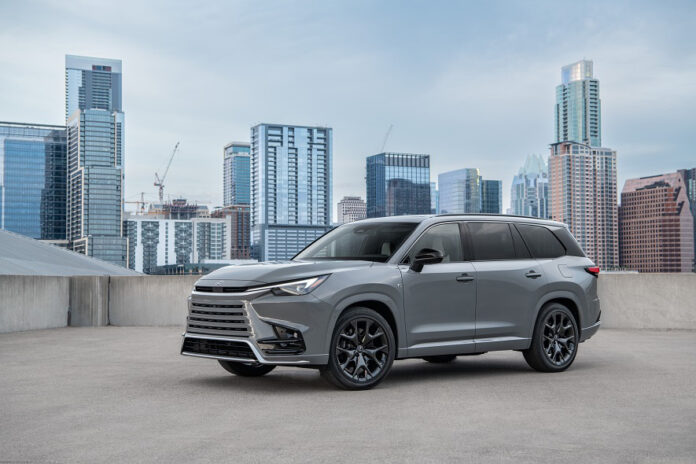(Austin, Texas) A little over a year ago, without flowers or wreaths, Lexus ended production of its only 7-seater utility vehicle built on a monocoque chassis within its range. Rather messy, the RX L nevertheless bequeathed valuable lessons to the designers of the TX, the model now called upon to replace it. Lessons learned?
Too cramped and clumsily designed in addition, the extended version of the RX L (2018-2023) has, throughout its short career, struggled to find its customers. The TX corrects these shortcomings. Its frankly more imposing dimensions ensure comfort and clearance for each passenger, “regardless of the seat they occupy” (dixit Lexus). This is partly true. The third row seats do not have the same softness as the others nor as many auxiliary jacks for connecting electronic devices. In fact, she only has one. On the other hand, there is no shortage of space and in this regard, the TX is among the most spacious in its category. The same goes for trunk volume. When all seats on board are occupied, the TX’s cargo area is three times that of the old RX L. Better yet, the TX also dominates its main rivals (Acura MDX, Audi Q7 and Infiniti Q60).
As for the style, the TX abandons the hypertrophied grille of the current Lexus in favor of banal horizontal slats, no doubt, but much more discreet and more aerodynamic. Many will be happy about it, but not everyone. As disproportionate as it is, this grille would at the very least have had the merit of standing out among this pack of SUVs that look more and more similar. In this regard, this leads us to remember that all modern vehicles are designed on a reduced number of technical platforms and then offered under different brands. The TX is no exception to this rule and some consumers will be tempted to see it as a Toyota Grand Highlander in its Sunday best, as these two vehicles have so much in common. Both originate on the same assembly line in the United States.
So why pay more? For the quality of the materials used on board the TX? For the extra attention to detail? For the more extended warranty (4 years/80,000 km versus 3 years/60,000 km at Toyota)? All good answers. But there is more. The TX offers a unique choice of engines (all capable of towing a load of 2,268 kg), a more rigid chassis, more sophisticated technologies (depending on the version) and better soundproofing.
Three mechanics compete for a place under the hood. The latter accommodates a supercharged four-cylinder at entry level (TX 350). On paper, this one produces 10 horsepower more than Toyota. The secret lies in the octane number and not in more efficient management or a larger diameter turbocharger. The TX prefers Premium gasoline, that’s all. Do you fill it with regular gasoline? This does not pose a problem, but there will be some absentees within the cavalry. Regardless, 10 horsepower more or less will make little difference to moving the TX. This engine turns out to be quite quick to get going, quite discreet under effort, but not the one that best suits the nature of this vehicle. Especially when it is full of passengers.
The TX 500h, which combines a gasoline engine with two electric motors, represents the sensible choice. Faster and more economical at the pump than the 2.4L (TX 350), the TX 500h also benefits from a sharper chassis which tries as much as possible to give pride of place to handling. Among its particularities, we find the four-wheel steering system which not only provides increased stability, but also reduces the turning circle. Let us also highlight an extended range of use of the all-wheel drive which allows up to 80% of the torque to be transferred to the rear axle compared to 50% in the case of the TX 350. Never mind, the TX 550 has no pretensions sporty, even if it is only offered in F-Sport versions. The steering lacks feel, understeer manifests itself quite early, but the driving remains overall predictable, without surprises. And dreary. Like that of the majority of SUVs, in fact.
Lexus will offer another hybrid version, but this time plug-in, in the next year. Called 550h, it promises to cover around fifty kilometers in fully electric mode. A 3.5-liter V6 provides thermal partitioning. The heart is there, but the presence of a continuously variable transmission (CVT) is surprising because of its limitations, particularly with regard to the maximum towing capacity of the TX. Far from being the ideal combination.
La Presse will soon publish the test of the following vehicles: Cadillac Lyriq, GMC Sierra, Lucid Air, Rivian R1S, Tesla Model Y, Toyota Tacoma. If you own one of these vehicles or are awaiting delivery, we would love to hear from you.















